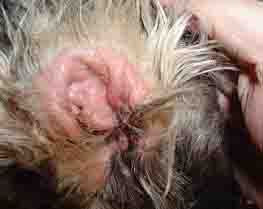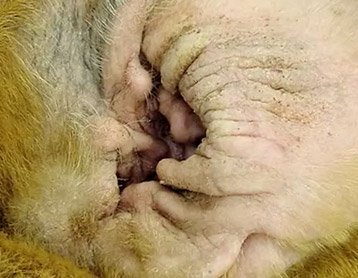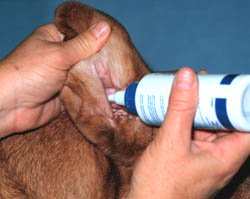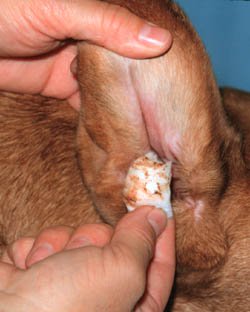Summary:
"Yeast infection in a dog's ear is the most common type of canine ear problem. Mild conditions can be treated with home ear cleaners with more severe or infected cases requiring a veterinarian. The condition often due to another condition, such as a food allergy reaction, which should be addressed in order to avoid future problems. In the case of a food allergy reaction, it requires a change in diet and possibly nutritional supplements. Some perpetuating factors, such as the natural dog ear anatomy, particularly in dogs with long pendulous ears, is a factor that requires some level of owner awareness, since problems are always a risk.
Treatment for mild conditions are topical, often using a combination of glucocorticoids, anti-fungal agents. The basic principal is to acidify the ear canal, making it undesirable for the growth of yeast. If bacteria are present as well, a veterinarian may opt for product that can address both. All treatments starts with a thorough cleaning of the ears. For more chronic cases, oral anti-fungal agents along with a glucocorticoid (prednisone) are used."
Overview
Yeast infections (malassezia) are common in dogs who have allergies and are the most common ear problem seen by veterinarians. Yeast is also referred to as Malassezia Dermatitis, which is a type of fungal infection. Dog ears contain mast cells, just like the mast cells contained in the respiratory systems of humans. These mast cells produce histamines, prostaglandins, and other inflammatory chemicals in response to allergens. These chemicals stimulate the ears to over-produce wax and other secretions. Skin bacteria thrive in the warm, gooey environment of these ears. Yeast spores are also attracted to the ears and begin to germinate.

Dogs with floppy ears are much more susceptible to yeast infection in dog ear than dogs with erect ears, because their ears provide a warm, dark place for yeast to grow.
Yeast infections (Malassezia otitis) may also be the result of an adverse food reaction or as a reaction to ear mites. In middle age dogs, allergy (atopy) or a problem with the endocrine gland (endocrinopathy) should be considered as well as reactions to food.
Several breeds have a higher propensity of yeast overgrowth:
- West Highland White Terrier
- Poodle
- Dachshund (need to rule out Acanthosis nigricans first, with is a
thickening of the skin)
- English Setter
- Basset Hound
- American cocker spaniel
- Shi Tzu
- Springer Spaniel
- German Shepherd
Symptoms
Symptoms of yeast infection in a dog ear include increased production of ear wax and other secretions. Ear wax may appear to be pinkish-brown and often the ear will have a bad smell.
You won't be able to see it without magnification, but your vet will notice upon examination with a magnifying device that the ear tissue has changed to become thicker and spongier.
Your dog's ears will itch. He will probably scratch or paw at them. He may also rub his nose with his paws, another a sign of allergies. Another sign of allergy is recurring ear infections during certain times of the year and no problems at other times.
In chronic cases the ears can change color (hyperpigmentation) and a thickening and hardening of the skin (lichenification) can occur.

Diagnosis
Your veterinarian may suspect a yeast infection based on the amount and color of the ear wax and other secretions. They will look at the ear tissue of your dog when examined with a magnifying device. An ear wax sample will be taken with a swab for examination under a microscope. The veterinarian will make a diagnosis based on the excessive number of yeast cells. Response to treatment can also be used to confirm a diagnosis.
The testing process will allow your veterinarian to rule out other types of infections. Secretions collected will be cultured for yeast, a test that takes 10 - 14 days in order for a diagnosis to be made. In the meantime, your vet will probably go ahead and begin treatment for a yeast infection.
Several conditions with similar symptoms to a yeast infection can cause a dog ear problem and will need to be ruled out before a definitive diagnosis is reached. These include:
- Flea allergy
- Food Allergy
- Atopy (environmental or seasonal allergy)
- Superficial bacterial folliculitis
- Seborrhea (both primary and secondary forms)
- Acanthosis nigricans (dachshunds only)
Treatment of Dog Ear Yeast Infections
Yeast infection in your dog's ear is treated first by cleaning out the ears with a gentle cleansing solution. When using an ear cleansing solution or wash, a few drops should be applied to the inside of the ear flap and then the tip of the ear wash bottle should be inserted a few millimeters into the ear canal. Do not tightly force the tip of the bottle into the ear canal as forceful squeezing of the bottle with the bottle wedged into the ear canal could rupture the ear drum.

Most dogs will shake their head after the wash is inserted into the ear, shaking out much of the solution. Massaging the wash solution into the dog's ear. A tip is to massage the base of the ear which distributes the wash throughout the ear canal.
Ear cleaning will remove any debris that might cause inflammation such as yeast. For swelling, a veterinarian may use glucocorticoids for up to two weeks. This will also eliminate any pain. As an alternative, a veterinarian may use NSAIDS. About 1/3 of dogs have an avoidance reaction to ear cleaning, making it easier to perform in the veterinarian's office.
They are then treated with a topical ointment that usually contains
an antifungal agent and glucocorticoids. Ointments with mineral oil are
thought to keep the ear clean without the need for additional separate
cleanings. Antifungal agents include Nystatin, clotrimazole 1%,
miconazole 1% and ketoconazole .1%. If tests show the presence of
bacteria and Malassezia otitis (fungal infection), there are
combination
products that address both.
In dogs that have a more chronic yeast infection in the dog's ear or
in cases where both bacterial and Malassezia is present, a veterinarian
may recommend an oral medication. Antifungal agents include
Keotconazole (5 to 10 mg/kg sid, given with food to enhance
absorption), itraconazole (5 mg/kg sid) and fluconazole (10 mg/kg sid).
In cases where the ear canal has narrowed (stenosis) or if there is
excessive fluid accumulation (edematous) a dog may be put on a
glucocorticoid (prednisone) for one to two weeks.
To control the inflammation and itching, an antihistamine such as benadryl may be recommended.
Since yeast infections are often related to allergies, the allergen(s) must be identified and dealt with. Often it is a food allergy. Switching your dog to a special diet for allergic dogs may help. Iams makes a lamb and rice food especially for dogs with allergy problems. Hills Science Diet has a formula for allergic dogs as well.
Treating a yeast infection can take up to three weeks, and if
allergies are the main cause and if they are not dealt with, the
infection usually returns.

21st Century Clean Ear Pads
The veterinarian will follow-up in 2 to 4 weeks after treatment begins to monitor progress. Symptoms such as any bad odors or itch will improve within 1 week. If the problem frequently occurs, a veterinarian will need to determine the underlying cause.
Home Remedies
Home use of an acetic acid/boric acid solution such as Dermapet Malacetic Otic can be effective in treating yeast infection. The ear cleaner or flush is used daily for 7-10 days by filling the ear canal to overflowing, massaging the base of the ear, and allowing the solution to remain in the ear canal for 5 minutes. Loosened debris is wiped off of the concave pinnal surface with a dry cotton ball. This procedure is repeated once daily. When the ear canal is clean, the cotton ball will remain fairly white when the solution is wiped away. At that time, home ear cleaning is reduced to once weekly.
If the problem happens often, you might want to consider a dietary supplement designed for ear conditions. Dog ears contain wax and a variety of flora (e.g. yeast and certain bacteria). This can be healthy and helps to keep ears clean and free of infection. Herbal products help to maintain the natural balance of flora and healthy organisms in the ear. A solution worth trying are ear drops made by Pet Alive Ear Dr. which contains a blend of herbs selected for ear health.
Brochure on Dog Ear Yeast Infection
References and Additional Reading on Canine Ear Problems and Yeast Infection:
Examining and Medicating the Ears of a Dog
Washington State University
College of Veterinary Medicine
Diseases of the Outer Ear
Haar, G. Ter DVM
Brevitz, Betsy
Hound Health Handbook
Malassezia Otitis Externa - Etiology and Treatment
L.N. Gotthelf
Animal Hospital of Montgomery
Montgomery, AL, USA
